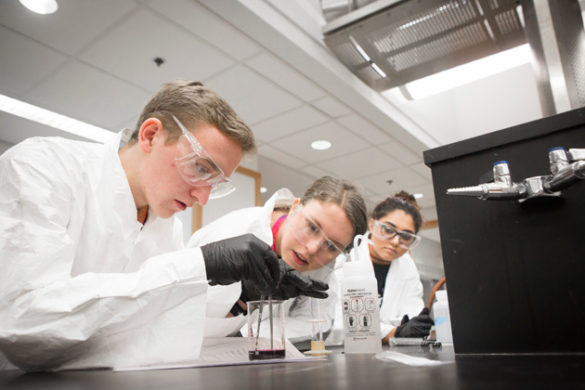
The Vanderbilt Institute of Nanoscale Science and Engineering recently hosted its 100th group of Middle Tennessee high school students for a daylong field trip to the VINSE laboratories, giving the students hands-on experience in science and technology.
Small groups of students from several Tennessee high schools participate in VINSE-sponsored field trips to the Vanderbilt campus each March, April and May. Since piloting the program in spring 2011, VINSE has hosted nearly 2,000 students from 52 high schools representing 19 Middle Tennessee counties.
Students from Portland High School in Robertson County and Kenwood High School in Montgomery County visited the VINSE labs on March 8. The students learned to make solar cells out of blackberry juice and measure the electrical power produced by the juice.
“This gives the students a hands-on introduction to the power of nanotechnology,” said Sandra Rosenthal, the Jack and Pamela Egan Professor of Chemistry and director of VINSE. “Many scientists and engineers believe that structuring solar cells on the nanoscale will lead to more efficient, less expensive devices that will encourage more widespread implementation of solar power.”

The students mashed blackberries, extracted their juice, soaked an electrode in the juice, coated another electrode with graphite and clipped them together to make a solar cell. After the solar cells were finished, the students got to measure the amount of electricity that each produced to see whose cell performed the best. These crude devices don’t produce a lot of electricity—about enough to power a small electronic calculator—but they can give a person a small shock.
The students also examined the material that they used to make the solar cells with one of VINSE’s scanning electron microscopes. These instruments can magnify objects by as much as 500,000 times, enough to allow the students to see nanoscale features that are 50,000 times smaller than the width of a human hair. Students also learned how these tiny features can affect how much sunlight a solar cell can capture.
VINSE is sponsored by Vanderbilt University and includes faculty and students from the School of Engineering, College of Arts and Science and the School of Medicine. The field trips are coordinated by VINSE program coordinator and outreach facilitator Sarah Ross-Satterwhite. They are funded by Vanderbilt.
Schools and counties that participated in the 2016-17 field trip program are:
- Clarkrange High School, Fentress County
- Columbia Central High School, Maury County
- Creek Wood High School, Dickson County
- East Nashville Magnet High School, Davidson County
- Fairview High School, Williamson County
- Gallatin High School, Sumner County
- Giles County High School, Giles County
- Greenbrier High School, Robertson County
- Hillwood High School, Davidson County
- Houston County High School, Houston County
- Kenwood High School, Montgomery County
- LEAD Academy, Davidson County
- Livingston Academy, Overton County
- Middle College High School, Davidson County
- Juliet High School, Wilson County
- Northwest High School, Montgomery County
- Portland High School, Robertson County
- Smith County High School, Smith County
- Spring Hill High School, Maury County
For more information, contact Sarah Ross-Satterwhite at (615) 343-6868 or vinse@vanderbilt.edu.